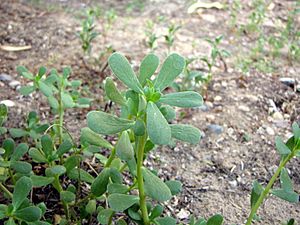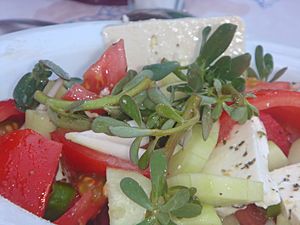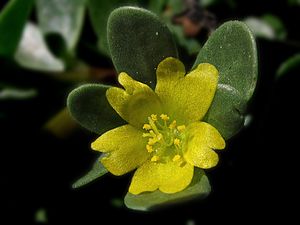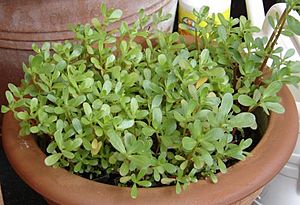Little hogweed facts for kids
Quick facts for kids Little hogweed |
|
|---|---|
 |
|
| Scientific classification | |
| Genus: |
Portulaca
|
| Species: |
oleracea
|
Portulaca oleracea (also called common purslane, duckweed, little hogweed, or pursley) is a type of plant that grows every year. It's a succulent plant, meaning it has thick, fleshy parts that store water, like a cactus. It belongs to the Portulacaceae family and can grow up to 40 centimeters (about 16 inches) tall. There are about forty different kinds of purslane grown today.
The name oleracea comes from Latin and means "vegetable" or "herbal." This plant has been eaten by people for a very long time because it's healthy. It has many different names in languages all over the world!
Contents
Where Purslane Grows
Purslane grows in many places around the world. It's found in North Africa, Southern Europe, the Middle East, India, and even in places like Malesia and Australasia. People think it spread so widely because humans carried its seeds as they traveled.
It's not totally clear how purslane got to the Americas. Some people think it's an "exotic weed" that arrived later. But there's also evidence that it was in North America as early as the 1300s. This suggests it might have reached the continent before Columbus arrived. Scientists believe that Native Americans might have eaten the plant and helped spread its seeds.
What Purslane Looks Like
Purslane has smooth, reddish stems that usually grow flat along the ground. Its leaves can grow in different ways: sometimes they are alternate (one leaf at a time along the stem), or opposite (two leaves directly across from each other). The leaves often grow in clusters at the joints and ends of the stems.
The flowers are yellow and have five petals. They are small, only up to 6 millimeters (about a quarter of an inch) wide. These flowers open for just a few hours on sunny mornings, usually in the center of a leaf cluster. Tiny seeds grow inside a pod that opens when they are ready. Purslane has a main root called a taproot and smaller roots that spread out. This helps it grow well even in poor or dry soils.
How Purslane Survives Dry Times
Purslane is special because it can use two different ways to make its food through photosynthesis. This is how plants use sunlight to grow. Most plants use only one way.
When there isn't much water, purslane can switch its method. This helps it save water and survive in dry conditions. It's like the plant has a clever trick to deal with drought!
A Look Back in Time
Purslane has been used for a very long time, especially in countries around the East Mediterranean Sea. Scientists have found its remains at many very old sites from prehistoric times. Seeds have also been found at ancient places dating back thousands of years, like in Greece.
Around 300 BC, a Greek writer named Theophrastus mentioned purslane as a summer herb that should be planted in April. Later, in the 1200s, it was listed as a common food in Milan, Italy.
People in ancient times even thought purslane had special healing powers. Pliny the Elder, a Roman writer, suggested wearing the plant as a charm to keep away bad things!
How People Use Purslane
Cooking with Purslane

| Nutritional value per 100 g (3.5 oz) | |
|---|---|
| Energy | 84 kJ (20 kcal) |
|
3.39 g
|
|
|
0.36 g
|
|
|
Protein
|
2.03 g
|
| Vitamins | Quantity
%DV†
|
| Vitamin A | 1320 IU |
| Thiamine (B1) |
4%
0.047 mg |
| Riboflavin (B2) |
9%
0.112 mg |
| Niacin (B3) |
3%
0.48 mg |
| Vitamin B6 |
6%
0.073 mg |
| Folate (B9) |
3%
12 μg |
| Vitamin C |
25%
21 mg |
| Vitamin E |
81%
12.2 mg |
| Minerals | Quantity
%DV†
|
| Calcium |
7%
65 mg |
| Iron |
15%
1.99 mg |
| Magnesium |
19%
68 mg |
| Manganese |
14%
0.303 mg |
| Phosphorus |
6%
44 mg |
| Potassium |
16%
494 mg |
| Zinc |
2%
0.17 mg |
| Other constituents | Quantity |
| Water | 92.86 g |
|
Link to USDA Database entry
|
|
| †Percentages estimated using US recommendations for adults. | |
Purslane can be eaten as a leaf vegetable. It has a slightly sour and salty taste. You can find it in many dishes across Europe, the Middle East, Asia, and Mexico. The stems, leaves, and even the flower buds can be eaten raw or cooked.
It's often used fresh in salads or stir-fried. You can also cook it like spinach. Because it has a slightly slimy quality (called mucilaginous), it's also good for soups and stews. The sour taste comes from natural acids in the plant, which are strongest when the plant is picked in the early morning.
Aboriginal Australians use purslane seeds to make special seedcakes. In Greece, people call it andrákla or glistrída. They use the leaves and stems with feta cheese, tomato, onion, garlic, oregano, and olive oil in salads. They also boil it or add it to chicken dishes.
In Turkey, purslane is used in salads and baked goods. It's also cooked like spinach or mixed with yogurt to make a dish similar to tzatziki. In Egypt, it's cooked as a vegetable dish, but usually not in salads.
Helping Other Plants
Purslane can also be a "companion plant" to other plants. This means it helps them grow better. It spreads out and covers the ground, which helps keep the soil moist for nearby plants.
Its deep roots can also bring up water and nutrients from deeper in the soil. Other plants can then use these. Some plants, like corn, can even follow purslane's roots down into harder soil that they couldn't get through on their own!
How Healthy is Purslane?
Raw purslane is mostly water (93%). It has some carbohydrates and protein, but very little fat. If you eat 100 grams of purslane, it gives you about 20 calories.
It's a great source of vitamin E and vitamin C. It also has good amounts of several minerals like magnesium and potassium. What's really special about purslane is that it's known as the best vegetable source of alpha-linolenic acid. This is an important type of omega-3 fatty acid that our bodies need.
Purslane in Pop Culture
The Spanish word for purslane is Verdolaga. This word is sometimes used as a nickname for South American football (soccer) clubs that have green and white colors in their uniforms. Examples include Atletico Nacional from Colombia and Ferrocarril Oeste from Argentina.
See also
 In Spanish: Verdolaga común para niños
In Spanish: Verdolaga común para niños



